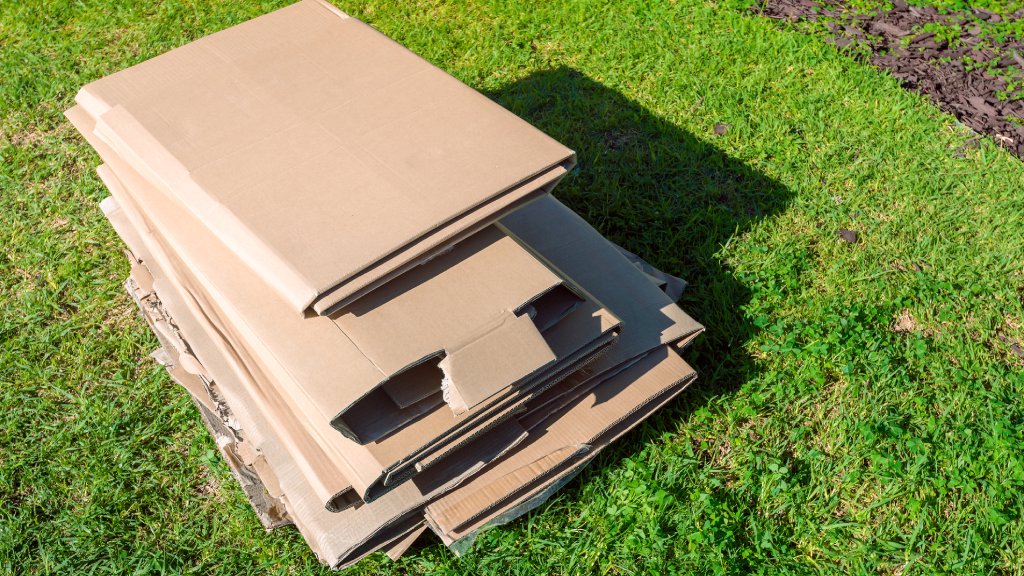Can You Kill Grass With Cardboard?
Try killing grass with cardboard, or sheet mulching. Killing grass with cardboard is an easy way to ditch the lawn.


If you’re looking for an inexpensive and natural way to kill grass, try killing grass with cardboard. Whether you are starting a new garden bed or ditching the lawn altogether, using cardboard, often called sheet mulching, is an easy method.
It can be as simple as laying out the cardboard, watering it, and covering it with mulch. As the grass dies out, the cardboard slowly decomposes, adding carbon to the soil. The mulch eventually degrades, too, further enriching the soil.
Many who ditch their lawns replace it with low-water and native plants that attract pollinators, not only saving money but bringing the garden alive with bees and butterflies.
Using Cardboard to Kill Grass
People are choosing to replace their lawns with drought-tolerant plants to save water and money. Let’s face it, keeping a lawn watered all summer can be expensive. And if you let the lawn go dormant, weeds can surface.
There are several natural ways to remove grass for a garden, including herbicides, solarizing, or using a sod cutter. Sheet mulching is more economical and it adds nutrients to the soil.
How Long Does It Take Cardboard to Kill Grass?
It can take three to five months to completely kill out weeds and grass. You can start in late winter or early spring. Heat will move the decomposition process faster and get your plot ready to plant by fall. In warm climates, you can start the process in early fall.
How to Sheet Mulch with Cardboard
To get started, collect large sheets of cardboard such as boxes from an appliance store. You also will need bricks, stones, or garden stakes to hold down the cardboard. Compost, if desired, and mulch will be needed.
Sign up for the Gardening Know How newsletter today and receive a free copy of our e-book "How to Grow Delicious Tomatoes".
- First, mow the lawn short and clear the weeds. This will reduce the vegetation as much as possible.
- Cover the area with 2 to 3 inches (5 to 7.6 cm) of compost or manure. Some people choose to skip this step but it is beneficial if you want to plant right away.
- After unfolding or cutting the cardboard boxes so they lay flat, start spreading them over the area, overlapping the sides by 6 to 8 inches (15 to 20 cm). It is important to overlap the cardboard to prevent weeds or grass from growing up through any glimmers of light.
- Wet the cardboard as you go to keep it from flying away during the layout. Set bricks or stones along the edges to keep it down. Or, pound in garden stakes to hold down the cardboard.
- Spread 4 to 6 inches (10 to 15 cm) of wood chip mulch on top of the cardboard. The mulch will hide the cardboard as it decomposes and help conserve moisture. Eventually, the mulch will decompose, too, also enriching the soil.
- If desired, you can plant right away, or ideally, wait several months to be sure the grass has died out and most of the cardboard has decomposed.
- While the area is barren, you can decorate it with pots of colorful annuals.
Why Ditch the Grass?
Water conservation, although it’s becoming increasingly important, is not the only good reason to replace a lawn. Replacing turf grass with native plantings supports pollinators and insects, which in turn support birds and wildlife. There is a movement gaining steam that finds gardeners replacing lawns with alternative plantings.
Turf lawns have been referred to as “dead zones” for wildlife. A green lawn is pretty, but environmentally is not practical or beneficial to the earth’s biodiversity. In addition to using loads of water, lawns often are treated with toxic chemicals to keep them green. It may be time to re-think that luscious green lawn and either replace it or reduce it with natives. Try cardboard sheet mulching for the quickest and easiest result and a great way to recycle and re-use cardboard.

After graduating from Oklahoma State University with a degree in English, Susan pursued a career in communications. In addition, she wrote garden articles for magazines and authored a newspaper gardening column for many years. She contributed South-Central regional gardening columns for four years to Lowes.com. While living in Oklahoma, she served as a master gardener for 17 years.